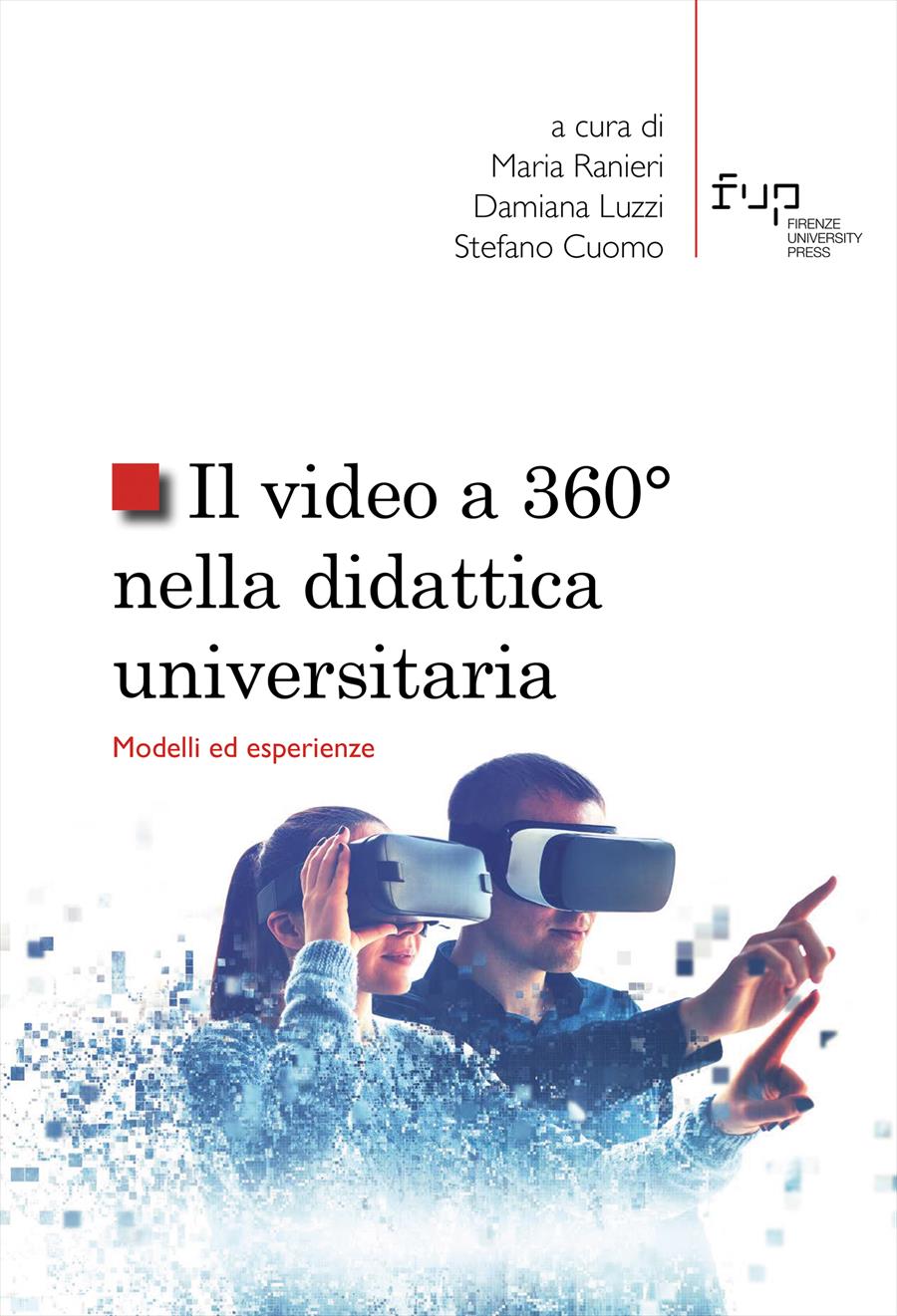- Il video a 360° nella didattica universitaria
- Edited by Maria Ranieri, Damiana Luzzi, Stefano Cuomo
Didattica immersiva all’università: obiettivi e azioni del progetto SEPA360
- Stefano Cuomo
- Maria Ranieri
- © 2022 Author(s) |
- CC BY 4.0
- DOI: 10.36253/978-88-5518-646-9.08
This chapter introduces the relevance of the digital technologies for a constant update of the teaching and learning practices in the Higher Education and the challenges to cope with for their effective development, especially in the pandemic and post-pandemic period. The Erasmus+ project SEPA360 aiming at introducing the emerging technology of video 360° as a tool for helping the students in enhancing their capability in learning is then presented together with the activities carried out in the SEPA360 Consortium.
- Keywords:
- immersive teaching,
- higher education,
- pedagogical innovation,
- faculty development,
- european project,
University of Florence, Italy - ORCID: 0000-0003-3174-7337
University of Florence, Italy - ORCID: 0000-0002-8080-5436
- Bronkhorst, Larike H., e Sanne F. Akkerman. 2016. “At the Boundary of School: Continuity and Discontinuity in Learning Across Contexts.” Educational Research Review 19: 18-35. DOI: 10.1016/j.edurev.2016.04.001
- Bruschi, Barbara, e Maria Ranieri. 2018. “University Education: Quality, Effectiveness, Teacher Training.” Form@re - Open Journal per La Formazione in Rete 18, 1: 1-6. DOI: 10.13128/formare-22954
- Coggi, Cristina, a cura di. 2019. Innovare la didattica e la valutazione in Università. Il progetto IRIDI per la formazione dei docenti. Milano: FrancoAngeli.
- Commissione europea. 2014. High Level Group on the Modernisation of Higher Education: Report to the European Commission on Improving the Quality of Teaching and Learning in Europe’s Higher Education Institutions. Publications Office. DOI: 10.2766/42468
- De Rossi, Marina, e Cinzia Ferranti. 2017. Integrare le ICT nella didattica universitaria. Padova: Padova University Press.
- EHEA - European Higher Education Area. 2015. Yerevan Communiqué. Yerevan.
- Elçi, Alev, Linda L. Beith, e Atilla Elçi, a cura di. 2019. Handbook of Research on Faculty Development for Digital Teaching and Learning. Hershey, PA: IGI.
- Federighi, Paolo, Maria Ranieri, e Gianfranco Bandini, a cura di. 2019. Digital Scholarship tra ricerca e didattica. Milano: FrancoAngeli.
- Felisatti, Ettore e Anna Serbati, a cura di. 2017. Preparare alla professionalità docente e innovare la didattica universitaria. Milano: FrancoAngeli.
- Galliani, Luciano, a cura di. 2011. Il docente universitario: una professione tra ricerca, didattica e governance degli atenei. Lecce: Pensa Multimedia.
- Gonzalez-Ramirez, Jimena, Kerri Mulqueen, Ruth Zealand, Sara Silverstein, Christine Reina, Shawna BuShell, e Shawn Ladda. 2021. “Emergency Online Learning: College Students’ Perceptions during the COVID-19 Pandemic.” College Student Journal 55, 1: 29-46.
- Hénard, Fabrice, e Deborah Roseveare. 2012. Fostering Quality Teaching in Higher Education: Policies and Practices. Paris: OECD Publishing.
- Hicks, Lydia J., Emile E. Caron, e Daniel Smilek. 2021. “SARS-CoV-2 and Learning: the Impact of a Global Pandemic on Undergraduate Learning Experiences.” Scholarship of Teaching and Learning Psychology. DOI: 10.1037/stl0000250
- Perla, Loredana, e Viviana Vinci, a cura di. 2022. Didattica, riconoscimento professionale e innovazione in Università. Milano: FrancoAngeli.
- Rossi, Pier Giuseppe. 2019. “L’ambiente digitale come terzo spazio nella didattica universitaria.” In Digital Scholarship tra ricerca e didattica, a cura di Federighi Paolo, Maria Ranieri e Gianfranco Bandini, 40-52. Milano: Franco Angeli.
- Tasso, Anthony F., Nesrin Hisli Sahin, e Gabrielle J. San Roman. 2021. “COVID-19 Disruption on College Students: Academic and Socioemotional Implications.” Psychological Trauma: Theory, Research, Practice, and Policy 13, 1: 9-15.
- UNESCO. 2021. COVID-19: Reopening and Reimagining Universities. Paris: UNESCO. Vallade, Jessalyn, Renee Kaufmann, Brandi N. Frisby, e Joe Martin. 2020. “Technology Acceptance Model: Investigating Students’ Intentions toward Adoption of Immersive 360° Videos for Public Speaking Rehearsals.” Communication Education 70, 2: 127-45. DOI: 10.1080/03634523.2020.1791351
Chapter Information
Chapter Title
Didattica immersiva all’università: obiettivi e azioni del progetto SEPA360
Authors
Stefano Cuomo, Maria Ranieri
Language
Italian
DOI
10.36253/978-88-5518-646-9.08
Peer Reviewed
Publication Year
2022
Copyright Information
© 2022 Author(s)
Content License
Metadata License
Bibliographic Information
Book Title
Il video a 360° nella didattica universitaria
Book Subtitle
Modelli ed esperienze
Editors
Maria Ranieri, Damiana Luzzi, Stefano Cuomo
Peer Reviewed
Number of Pages
164
Publication Year
2022
Copyright Information
© 2022 Author(s)
Content License
Metadata License
Publisher Name
Firenze University Press
DOI
10.36253/978-88-5518-646-9
ISBN Print
978-88-5518-645-2
eISBN (pdf)
978-88-5518-646-9
Series Title
Studi e saggi
Series ISSN
2704-6478
Series E-ISSN
2704-5919
